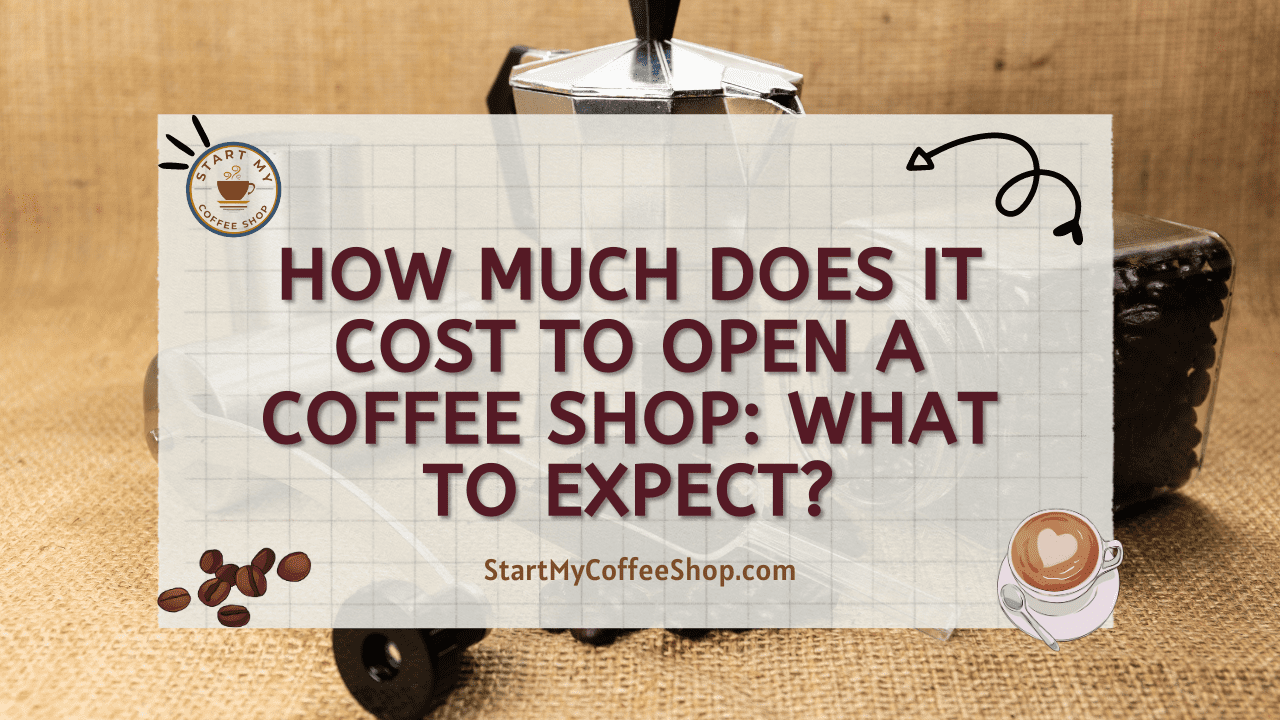Coffee shops have become an integral part of our daily lives, providing a cozy ambiance, delicious beverages, and a hub for social interaction. If you’re passionate about coffee and dreaming of opening your coffee shop, one of the first things you need to consider is the cost involved.
The cost to open a coffee shop can vary widely depending on factors such as location, size, equipment, concept, staffing, marketing, and contingencies. Generally, you need to have at least $80,000 to $300,000 or more.
In this article, I will explore the various factors that contribute to the cost of opening a coffee shop, from location and equipment to staffing and marketing.
So grab a cup of your favorite brew and let’s dive in!
1. Location:
 While a prime location can offer excellent visibility and exposure, it’s crucial to carefully consider the financial implications. The increased rental costs can put a strain on your budget, particularly during the initial stages of your coffee shop’s operation. It’s essential to strike a balance between affordability and visibility to maximize your chances of progress.
While a prime location can offer excellent visibility and exposure, it’s crucial to carefully consider the financial implications. The increased rental costs can put a strain on your budget, particularly during the initial stages of your coffee shop’s operation. It’s essential to strike a balance between affordability and visibility to maximize your chances of progress.
On the other hand, opting for a quieter area with lower rent may seem like an attractive option to reduce costs. However, it’s important to thoroughly assess the potential customer flow in such areas. If the foot traffic is significantly lower, your coffee shop may struggle to attract enough customers to sustain the business. Achieving the right balance between affordability and a sufficient customer base is key.
To make an informed decision about the ideal location for your coffee shop, conducting thorough research is crucial. Analyze the demographics of the area, consider nearby businesses, and understand customer behavior.
Factors such as proximity to offices, schools, residential areas, and transportation hubs should be taken into account. Understanding the preferences and habits of your target audience will help you determine the most suitable location for your coffee shop.
It’s important to note that while a prime location can bring numerous benefits, such as high visibility and accessibility, it’s essential to carefully evaluate the financial feasibility. Striving for a location that strikes a balance between affordability and visibility will lay a solid foundation for your coffee shop’s improvement.
Take the time to explore different options, weigh the pros and cons, and choose a location that aligns with your budget and long-term goals.
2. Equipment and Furnishings:
 To create that perfect cup of coffee, having the right equipment is essential. The list of necessary items includes espresso machines, grinders, coffee brewers, and blenders. These tools of the trade play a crucial role in ensuring the quality and consistency of the beverages you serve. However, it’s important to note that quality equipment often comes with a substantial price tag, so careful budgeting is necessary.
To create that perfect cup of coffee, having the right equipment is essential. The list of necessary items includes espresso machines, grinders, coffee brewers, and blenders. These tools of the trade play a crucial role in ensuring the quality and consistency of the beverages you serve. However, it’s important to note that quality equipment often comes with a substantial price tag, so careful budgeting is necessary.
Investing in a reliable espresso machine is of utmost importance, as it forms the backbone of your coffee shop. Consider factors such as its capacity, functionality, and durability when selecting the right one for your business.
A high-quality grinder is equally important to achieve the desired grind size and freshness of the coffee beans. Coffee brewers, whether manual or automatic, should be chosen based on the volume of customers you anticipate serving.
In addition to coffee-specific equipment, don’t forget about the furnishings that contribute to creating a welcoming and comfortable atmosphere for your customers. Tables and chairs should be chosen with both functionality and aesthetics in mind.
Comfortable seating arrangements are crucial to encourage customers to relax and savor their coffee experience. Display cases for pastries and other food items not only enhance the presentation but also play a role in enticing customers to indulge.
While the cost of equipment and furnishings can be significant, it’s important to view them as an investment in the long-term growth of your coffee shop. Quality equipment will not only contribute to the consistency and excellence of your coffee but also ensure durability, minimizing the need for frequent replacements or repairs.
To manage costs effectively, research different suppliers and compare prices. Consider both upfront costs and long-term maintenance requirements when making purchasing decisions. Don’t hesitate to seek advice from industry professionals or experienced coffee shop owners to make informed choices.
Remember, providing your customers with a top-notch coffee experience requires more than just quality beans and skilled baristas. It requires the right equipment and thoughtfully selected furnishings to create an inviting ambiance that keeps customers coming back for more.
3. Renovations and Interior Design:
When it comes to opening a coffee shop, transforming a space into a cozy and inviting environment is an essential aspect of creating a memorable experience for your customers. This transformation often involves renovations and interior design work to ensure that the space reflects the ambiance and atmosphere you envision for your coffee shop.
Renovations may include tasks such as painting the walls, replacing or refinishing the flooring, and upgrading the lighting fixtures. These elements contribute to the overall aesthetics and ambiance of the coffee shop. The cost of renovations will depend on various factors, including the condition of the space and the extent of customization you desire.
Painting the walls can instantly breathe new life into the space, setting the tone and creating a welcoming atmosphere. Choosing colors that align with your brand and create a cozy vibe is important.
Flooring options range from hardwood to tiles or carpeting, with each offering different advantages in terms of durability and aesthetics. Investing in quality flooring ensures longevity and a polished appearance for your coffee shop.
Lighting is another crucial aspect that can greatly enhance the ambiance. Well-placed lighting fixtures can create a warm and inviting atmosphere, while also highlighting specific areas such as the coffee bar or seating areas. Consider both natural and artificial lighting sources to strike the right balance.
Creating a comfortable seating area is vital to encourage customers to linger and enjoy their coffee. Invest in comfortable chairs, couches, and tables that match the overall theme and provide adequate space for individuals and groups. Adding cozy touches such as cushions, throw blankets, or artwork can further enhance the comfort and visual appeal of the space.
It’s important to set a budget for renovations and prioritize the areas that will have the most impact on the customer experience. Research and compare prices from different suppliers to make cost-effective choices without compromising on quality.
Remember, the overall ambiance and interior design of your coffee shop are integral to attracting and retaining customers. By creating a cozy and inviting space through renovations, interior design, and thoughtful details, you can provide a memorable coffee shop experience that keeps customers coming back for more.
Read more about Cost to Open Coffee Stand: Evaluating the Financial Commitment to a Coffee Stand
4. Licenses and Permits:
When embarking on the journey of opening a coffee shop, it’s important to navigate the legal landscape and ensure compliance with the necessary licenses and permits. The specific licenses and permits required can vary depending on your location and the scope of your operations. Understanding these requirements and allocating funds for the necessary paperwork is an essential part of the process.
Health permits are one of the primary licenses you will need to obtain. These permits ensure that your coffee shop meets the health and safety standards set by local authorities. They typically involve inspections of the premises, equipment, and food handling practices to ensure a clean and hygienic environment for both employees and customers.
Food service licenses are another crucial requirement, particularly if you plan to offer a menu beyond just beverages. These licenses demonstrate your compliance with food safety regulations and ensure that your coffee shop is qualified to handle and serve food items.
Additionally, you may need to acquire business permits that allow you to legally operate your coffee shop. These permits vary depending on local regulations and can include general business licenses or specific permits for operating in certain areas or zones.
If you plan to serve alcoholic beverages, you will also need to explore the requirements for obtaining a liquor license. Liquor licenses are subject to additional regulations and may involve additional fees and restrictions.
To ensure a smooth licensing process, conduct thorough research on the specific requirements and regulations in your area. Local government websites or licensing agencies can provide valuable information regarding the necessary permits and the application process.
Consider consulting with professionals such as lawyers or consultants with experience in the food and beverage industry to ensure you have a comprehensive understanding of the legal requirements.
Remember to allocate funds for the fees associated with the licenses and permits. The costs can vary depending on the location and the type of permits required. It’s crucial to include these expenses in your budgeting process to avoid any financial surprises along the way.
5. Inventory and Supplies:
To maintain the smooth operation of your coffee shop, it’s crucial to keep a well-stocked inventory of the necessary supplies. This encompasses a range of items, including coffee beans, milk, syrups, pastries, and other ingredients specific to your menu offerings. Managing your inventory effectively requires striking a balance between avoiding wastage and ensuring you have enough supplies to meet customer demands.
One of the key elements of an excellent coffee shop is the quality of its coffee. Selecting high-quality coffee beans is paramount to delivering a superior coffee experience to your customers. Consider partnering with reputable coffee suppliers who can provide a consistent and reliable source of beans that align with your desired flavor profiles.
In addition to coffee beans, stocking up on milk is essential, as it forms the foundation of many popular coffee beverages. Regularly assess the demand for different types of milk, such as whole, skim, or plant-based options, to ensure you have an appropriate quantity on hand.
Syrups and flavorings add variety to your menu and allow customers to personalize their drinks. Consider popular flavors such as vanilla, caramel, or hazelnut, and monitor their usage to gauge how much to stock. It’s essential to maintain a balance between having enough variety for customers’ preferences and minimizing the risk of excess waste.
When it comes to pastries and other food items, carefully curate your selection based on customer preferences and demand. Partnering with local bakeries or investing in in-house baking capabilities can ensure a fresh and enticing assortment of pastries to complement your coffee offerings.
Regularly monitoring inventory levels and sales data can help you make informed purchasing decisions. Utilize inventory management systems or software to track and analyze trends, enabling you to optimize stock levels and reduce waste. Establish relationships with reliable suppliers to ensure a consistent flow of inventory while also negotiating favorable pricing and terms.
6. Staffing Costs:
To determine the number of employees you’ll need, analyze projected foot traffic and take into account the size of your coffee shop and the services you offer. Assess peak hours and busy periods to determine the optimal staffing levels required to ensure efficient customer service. Roles such as baristas, cashiers, servers, and managerial positions should be considered based on the specific needs of your coffee shop.
Wages will make up a significant portion of your staffing costs. Research average wages in your area for similar positions to offer competitive compensation that attracts and retains talented individuals. It’s crucial to comply with labor laws and regulations regarding minimum wage, overtime, and benefits to ensure fair treatment of your employees.
Benefits, such as health insurance, retirement plans, and paid time off, are additional considerations. Although they increase your budget, offering competitive benefits is essential for attracting and retaining quality employees. Such benefits contribute to employee loyalty, motivation, and job satisfaction, ultimately enhancing customer service.
Training expenses should also be factored in, especially for new hires or staff members who require additional skills. Allocate resources for training programs, materials, and the time invested by trainers. Ongoing training contributes to improving the skills and knowledge of your team, resulting in enhanced efficiency and customer experience.
To manage staffing costs effectively, create a flexible schedule that aligns with customer demand. This allows you to optimize your workforce while avoiding overstaffing during slower periods. Additionally, monitor employee performance and productivity to identify areas for improvement and ensure efficient operations.
Read more about Cost to Open Scooter’s Coffee Shop: Mapping Out the Financial Landscape
7. Marketing and Advertising:
One of the first steps in your marketing strategy should be creating a professional website. A well-designed website allows potential customers to learn about your coffee shop, browse your menu, and access important information such as location and opening hours. It serves as a virtual storefront, showcasing your brand and enticing visitors to visit in person.
Utilizing social media platforms is another powerful marketing tool. Establish an active presence on popular platforms such as Facebook, Instagram, and Twitter. Engage with your audience by sharing appealing photos of your coffee and food offerings, posting updates about special promotions or events, and responding to customer inquiries.
Social media provides an opportunity to build a community around your coffee shop and generate excitement and loyalty among your followers.
Consider local promotions and collaborations as well. Partnering with other businesses, such as local bakeries or artisans, can create cross-promotional opportunities and expand your reach. Participate in community events and engage with local organizations to showcase your coffee shop and develop connections within the community.
Allocate a portion of your marketing budget for hosting or sponsoring community engagement events. This could include coffee tastings, workshops, or charity fundraisers. These events not only create a positive image for your coffee shop but also offer an opportunity to engage with potential customers and build lasting relationships.
Track the effectiveness of your marketing efforts by monitoring metrics such as website traffic, social media engagement, and customer feedback. This data will provide valuable insights into what strategies are working and where adjustments may be needed.
8. Utilities and Overhead Expenses:
Operating a coffee shop involves ongoing expenses that must be considered to ensure the financial sustainability of your business in the long run. These recurring costs include utility bills, rent or mortgage payments, insurance, and taxes. Carefully budgeting for these expenses is crucial for the smooth operation of your coffee shop.
Utility bills, such as electricity, water, and gas, are essential for running your coffee shop. Energy-efficient equipment, such as coffee machines and refrigeration units, can help minimize these costs. Regularly monitor your energy usage and explore ways to reduce consumption without compromising the quality of your offerings.
Rent or mortgage payments represent a significant portion of your expenses. Prime locations in bustling areas often come with higher rental prices, while purchasing a property can involve mortgage payments. Carefully consider the location and size of your coffee shop, balancing visibility with affordability to find a space that suits your budget and attracts customers.
Insurance is another important consideration. Protecting your coffee shop from unforeseen events, such as accidents, theft, or liability claims, is essential. Explore different insurance options, such as general liability insurance and property insurance, to ensure adequate coverage for your business.
Taxes are a necessary aspect of running any business. Familiarize yourself with the tax regulations applicable to your coffee shop, including income tax, sales tax, and employment tax. Consult with a tax professional or accountant to understand your obligations and ensure compliance.
By accounting for these recurring expenses in your budget, you can better manage your cash flow and plan for the financial stability of your coffee shop. Regularly review and evaluate your expenses to identify potential areas for cost savings or efficiency improvements. Maintaining a solid understanding of your financial commitments will contribute to the overall performance of your coffee shop.
9. Contingency Fund:
In the unpredictable world of business, it’s crucial to be prepared for unexpected expenses that may arise during the opening and operation of your coffee shop. While careful planning and budgeting can help minimize surprises, it’s wise to establish a contingency fund to handle unforeseen costs, such as equipment repairs, emergencies, or unforeseen delays in opening your coffee shop.
This contingency fund will provide peace of mind and serve as a safety net to help you navigate any bumps along the way.
Equipment repairs are a common unexpected expense in the coffee shop industry. Despite investing in high-quality equipment, wear, and tear, breakdowns, or malfunctions can occur. Having a contingency fund specifically designated for equipment repairs ensures that you can promptly address any issues and minimize downtime, ultimately safeguarding the smooth operation of your coffee shop.
Emergencies can also strike unexpectedly, such as unforeseen damages caused by natural disasters or accidents. Having a financial buffer can help you swiftly recover and restore your coffee shop without significant disruptions to your business. It’s advisable to consult with insurance providers to assess the appropriate coverage for potential emergencies and consider including emergency funds in your contingency plan.
Furthermore, unforeseen delays in opening your coffee shop can occur due to various factors beyond your control, such as construction delays, permit issues, or unexpected regulatory requirements. These delays can result in additional expenses, including extended rental costs or temporary alternative arrangements.
By allocating funds for such scenarios, you can minimize the financial impact and navigate through these challenges with greater ease.
It’s important to regularly review and replenish your contingency fund to ensure it remains adequate for your business needs. As your coffee shop grows and evolves, the size of your contingency fund may need adjustment to account for potential risks and expanding operations.
Summary
Opening a coffee shop requires careful financial planning and budgeting. While the cost can vary depending on factors such as location, size, and concept, understanding the key elements that contribute to the overall expense is essential. By considering factors like location, equipment, staffing, marketing, and contingencies, you can create a realistic budget and increase the chances of achievement for your coffee shop.
So, if you’re passionate about brewing the perfect cup of coffee and providing a delightful experience for customers, take the plunge and embark on your coffee shop journey today!
Frequently Asked Questions
Question: What are the ongoing expenses involved in running a coffee shop?
Ongoing expenses for a coffee shop include rent or mortgage payments, utilities (electricity, water, gas), inventory and supplies, staffing costs, marketing expenses, insurance, taxes, and general maintenance.
Question: Is it necessary to have prior experience in the coffee industry to open a coffee shop?
While prior experience in the coffee industry can be beneficial, it is not an absolute requirement.
Question: Are there any financing options available for aspiring coffee shop owners?
Yes, aspiring coffee shop owners can explore various financing options such as small business loans, grants, crowdfunding, partnerships, or personal savings.
To learn more on how to start your own coffee shop checkout my startup documents here
Please note: This blog post is for educational purposes only and does not constitute legal advice. Please consult a legal expert to address your specific needs.

Hi! I’m Shawn Chun
My adventure in coffee began when I first launched my first coffee shop back in the early 2000s. I had to figure out so many things on my own and to make it worse within 2 years of opening two large corporate coffee chains moved in just blocks away from me!
As I saw smaller and even some larger coffee shops in the neighborhood slowly lose customers to these giant coffee chains and slowly close up shop, I knew that I had to start getting creative…or go out of business.
I (like you may be) knew the coffee industry well. I could make the best latte art around and the foam on my caps was the fluffiest you have ever seen. I even had the best state-of-the-art 2 group digital Nuova Simonelli machine money could buy. But I knew that these things alone would not be enough to lure customers away from the name brand established coffee shops.
Eventually, through lots of trial and error as well as perseverance and creativity I did find a way to not only survive but also thrive in the coffee/espresso industry even while those corporate coffee chains stayed put. During those years I learned to adapt and always faced new challenges. It was not always easy, however, in the end, I was the sole survivor independent coffee shop within a 10-mile radius of my location. Just two corporate coffee chains and I were left after that year. All told the corporate coffee chains took down over 15 small independent coffee shops and kiosks and I was the last one standing and thriving.
Along the years I meet others with the same passion for coffee and I quickly learned that it is not only “how good a barista is” that makes a coffee shop successful, but the business side of coffee as well.
Hence why I started this website you are on now. To provide the tools and resources for up and coming coffee shop owners to gain that vital insight and knowledge on how to start a coffee shop successfully.
Stick around, browse through my helpful blog and resources and enjoy your stay! With lots of LATTE LOVE!
Shawn






